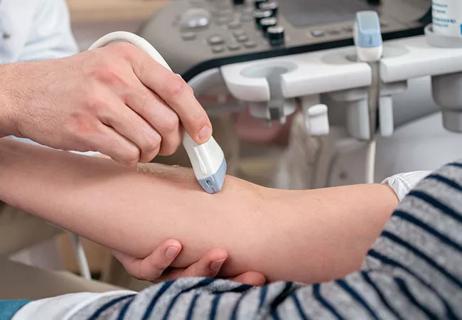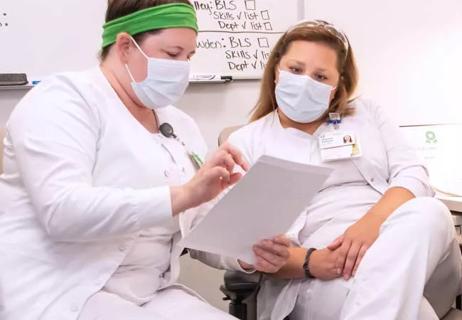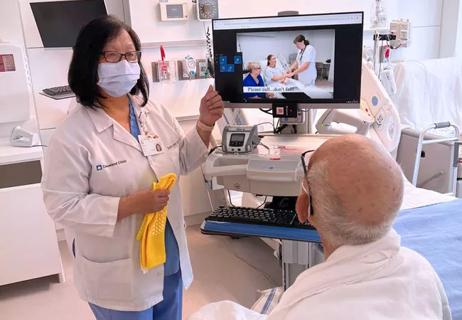A few years ago, Unit-based Skin Care Nurses and the Nursing Wound Care Team at Cleveland Clinic began to notice a lot of perianal ulcers on patients who required a fecal management system (FMS). “Sometimes the ulcers were severe enough to stop using the FMS, and other times the physician would indicate that the benefits of its use outweighed the minor severity of the ulcer,” recalls Mary Ann Sammon, BSN, WOCN, CWCN, retired Manager of Nurse Quality Enterprise Wound Care for Cleveland Clinic.
Cleveland Clinic is a non-profit academic medical center. Advertising on our site helps support our mission. We do not endorse non-Cleveland Clinic products or services. Policy
At the time, Cleveland Clinic was in the midst of changing FMSs. “The new system was promoted as preventing leakage because of the shape of the internal bulb,” says Sammon. “We wondered if it would also prevent perianal ulcers.” This led Sammon and a team of six other nurses to conduct a research study comparing the occurrence of anal erosion with two fecal management systems.
Cleveland Clinic wound care nurses, clinical nurse specialists from the medical-surgical ICU and Unit-based Skin Care Nurses met with the research team to discuss the extent of the problem and the feasibility of conducting a research study. The group shared thoughts on the identification and possible staging of anal ulcers and perianal damage from FMSs. They discussed how development of anal erosion may be associated with the length of time the FMS was in place and the presence of perianal edema or other comorbidities. The group agreed that a research study would be valuable.
Sammon, who served as principal investigator of the research study, initiated a literature review and discovered the following:
From there, the research team developed research questions. The goal was to determine the prevalence of anal erosions within a 14-day period among adult ICU patients who received one of two FMSs through random assignment. Anal erosion was defined as localized mucous membrane tissue impairments of the anal canal caused by corrosive fecal enzymes and/or indwelling devices.
The study group included 79 adult patients in critical care units on Cleveland Clinic’s main campus who had an FMS ordered by a physician or licensed independent practitioner. Inclusion criteria were:
There were several exclusion criteria, including rectal or anal injury, active bleeding, rectal or anal tumors, severe hemorrhoids, fecal impaction, loss of rectal tone or prolapsed anal sphincter, severe rectal or anal stricture or stenosis, diseases of the rectal mucosa and colon, and rectal surgery within the last year.
Data collection ran from May 2011 to April 2012. Nurse researchers inserted one of two FMSs and assessed patients daily for anal erosion. They collected data on patient demographics, medical history and insertion date, the reason for the FMS, diet, body mass index, ease of insertion and removal, amount of resistance, and when and why the device was removed. In addition, each day the nurse researchers collected data on the volume of water in the balloon and the balloon pressure. Occurrences of anal ulcer or erosion were compared using logistic regression models that adjusted for the length of system use and time-to-event using Kaplan-Meier estimates and log rank tests.
The incidence of anal erosion was 12.7 percent, well below the perceived rate by nurses. In addition, there were no differences in incidence of anal erosion between the two groups – 12.2 percent for patients on one of the fecal management systems and 13.2 percent for patients using the other FMS. Stool leakage occurred in 70 percent of patients and was associated with anal erosion.
Based on the research findings, Sammon and the other nurse researchers drew several conclusions. The first one relates to FMS product evaluations. “One selling point for an FMS would certainly be prevention of anal erosion, along with cost, ease of use, decrease in odor and prevention of incontinence associated with dermatitis,” says Sammon. “Our conclusion that there was no difference in the incidence of anal erosion among our two groups means that the ability to prevent anal erosions should not be a consideration. The paper can be referenced by other institutions when evaluating FMS in their facility. Nurses can put more weight on the other considerations.”
Sammon adds that the other data calculated and summarized by nurse researchers may help clinicians develop innovative options to prevent anal erosion. “This data can be used to justify the practice of daily nursing assessment of the patient’s anal area when FMS is in use and to critically review how long the FMS should be used in a patient,” she says. Sammon adds that more research into FMSs is needed, particularly in the areas of balloon water volume, mucosa pressure generation, ways to prevent anal erosion, staging of anal erosion and methods to heal erosions when an indwelling FMS is in place.
The results of the study, entitled “Randomized Controlled Study of the Effects of 2 Fecal Management Systems on the Incidence of Anal Erosion,” were published in the May/June 2015 issues of the Journal of Wound, Ostomy and Continence Nursing.

Study shows ultrasound can be valuable tool for improving patient satisfaction by reducing failed IV insertions

New system uses vital signs to predict need for further intervention

Findings reveal personal and professional factors that influence nurses’ interest in medical research

Nurse scientists bridge divide between bench and bedside

Individual and population factors play a role

Study looks at cardiopulmonary arrest and activation rates

Video education and nurse-led reinforcement help with fall risk awareness

Further research into collaborations may help strengthen nursing science